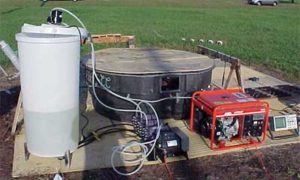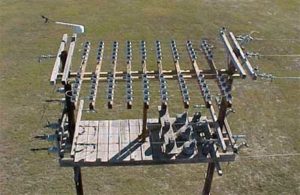
The picture above shows a fog Chamber used to Investigate the Leakage Current Behavior
of Insulators Exposed to Simulated Atmospheric Wetting.
Project Scope:
Distribution faults, abnormal electrical events and incipient fault conditions can be best described using the terms detection, classification, and location. PSAL researchers have developed several digital signal processing-based algorithms that allow for the detection of abnormal events on distribution systems. It was these algorithms that resulted in the successful implementation of a high impedance fault detection system, since these low current faults could not be detected using conventional means. These algorithms will be utilized and adapted for the purposes of this project.

Setup to Investigate the Leakage Current Behavior of Insulators Exposed to Natural Atmospheric Wetting.
Classification of abnormal events is very important. If an abnormal event is known to be a failing insulator versus a permanent fault or tree limb contact, appropriate action can be taken. Furthermore, utilities need as much
advance information as possible concerning abnormal events in order to properly schedule maintenance and determine the priority
and/or emergency status of repairs. PSAL has considerable experience in monitoring and studying various events on distribution systems and has began efforts to classify and electrically describe these events. Additional development and research is needed in this area.
Location of faults, incipient faults, and other events on distribution systems is a primary objective. PSAL’s prior experience in the detection of very low current events, phase identification, load analysis, and broad bandwidth, spectral analysis of distribution electrical signals will be used to address the fault location problem. PSAL has developed expert system techniques for application to intelligent distribution relays that General Electric commercialized. These same techniques will be used to address the fault location problem by using multiple parameters and information sources, both electrical and non-electrical, to improve the accuracy of fault location.
Researchers:
Principal Investigator: Dr. B. Don Russell
Co-Principal Investigator: Dr. Karen L. Butler-Purry
Co-Principal Investigator: Carl Benner
Sponsor: Project Duration:
Electric Power Research Institute 1997-2001
Research Assistants:
Christopher Richards Kwame Andoh
Karthick Menivannan Fang Shun Mung
Ujjwal Rajbhandari Mijanur Rahman